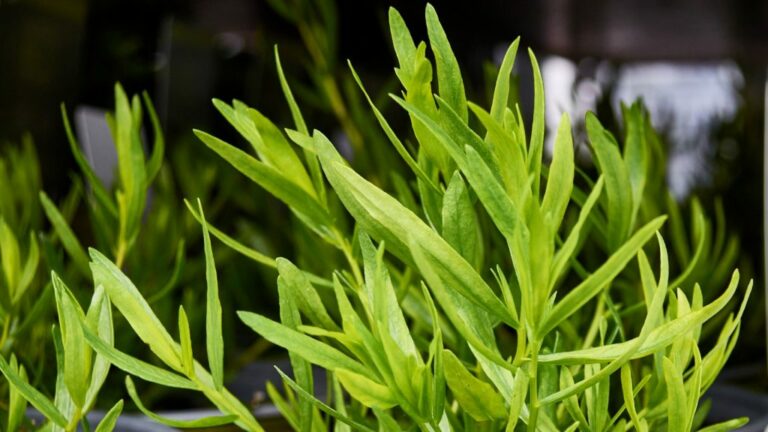The enchanting Tarragon Plant (Artemisia dracunculus) originates from Eurasia. This aromatic herb has captured the hearts of gardeners and culinary enthusiasts with its slender, emerald-green leaves and delicate clusters of pale yellow flowers.
But its beauty is not just skin-deep! The leaves of this herb are bursting with a distinct anise-like flavor, making it a prized ingredient in French cuisine.
Fear not, fellow gardeners, for caring for Tarragon is a breeze. With moderate watering and a sunny spot, you’ll be rewarded with a bountiful harvest of this divine herb.
Common Tarragon varieties:
- Russian tarragon
- French tarragon
- Mexican tarragon
Care
As mentioned, Tarragon is pretty easy to care for even for beginner green thumbs. Just pay attention to these aspects:
- Soil: Tarragon thrives in well-drained, sandy, light soil, as it is a drought-resistant herb that dislikes wet conditions, while a rich, acidic, moist soil can lead to poor growth, root rot, and diminished flavor.
- Water: The watering frequency of Tarragon depends on weather conditions and plant maturity, with young plants benefiting from alternate day watering during hot, dry spells, while mature plants require light watering every few days; avoid overwatering as it can reduce growth.
- Temperature: This is a resilient plant that can tolerate various temperatures and even survive cold snaps, but it prefers to avoid the intense heat, sun, and high humidity;
- Light: it doesn’t thrive in direct sun in hot climates; while full sun is acceptable in milder regions, it’s preferable to choose a location with dappled or early morning sun.
If you are looking for plants you can grow easily, check out Tomato, Mustard or Garlic!
Propagation
Tarragon is not difficult to propagate, allowing for a continuous supply in your garden. It can be done through stem cuttings or root division, as this herb does not produce fertile flowers. Select a young stem around five to six inches long, remove the leaves from the bottom third, and place it in moist potting soil after applying the rooting hormone. Root division can be done in late fall or early spring by cutting the root ball in half and replanting the divisions.
Pruning
You can prevent bolting if you remove flowers from your tarragon before they bloom. Knowing the right time to harvest is essential. Late spring is when Tarragon grows the most, offering a bountiful harvest.
- Start by removing your plant’s dry, brown, or dead-looking parts. It’s easier to do this before your harvest rather than afterward.
- When the plant reaches about 3 inches above the soil, you can take anything above that, but remember not to remove more than 20% of the plant. Snip off the newer, lighter shoots for the best flavor and encourage further growth.
- Use clean scissors to ensure leaf health, and don’t forget to enjoy the fruits of your labor!
Common Pests & Diseases
Frequently Asked Questions
French and Russian tarragon differ in flavor and growth. French tarragon (Artemisia dracunculus var. sativa) is prized for its delicate anise-like taste, propagated through cuttings. Russian tarragon (Artemisia dracunculoides) has a milder flavor, grown from seeds but is considered inferior. French tarragon is preferred for its superior taste and is widely used in cooking.
What are the 3 varieties of tarragon?
The three main varieties of tarragon are French tarragon (Artemisia dracunculus var. sativa), Russian tarragon (Artemisia dracunculoides), and Mexican tarragon (Tagetes lucida).
Can you grow tarragon from cuttings?
To propagate French tarragon, gather 4 to 6-inch stem cuttings in the morning, remove the lower leaves, dip in rooting hormone, and plant in warm, moist potting media, ensuring periodic misting.
Does tarragon grow slowly?
Yes, tarragon is known to have a relatively slow growth rate. It typically takes time to establish and develop into a mature plant. Patience is key when growing tarragon as it may require several growing seasons before reaching its full potential. However, once established, tarragon can be a resilient and long-lived herb in the garden.
Should I cut back tarragon?
In late spring, trim tarragon plants to about six inches to stimulate branching and new growth, and consistently harvest or clip stems to promote abundant and bushy growth throughout the season.


